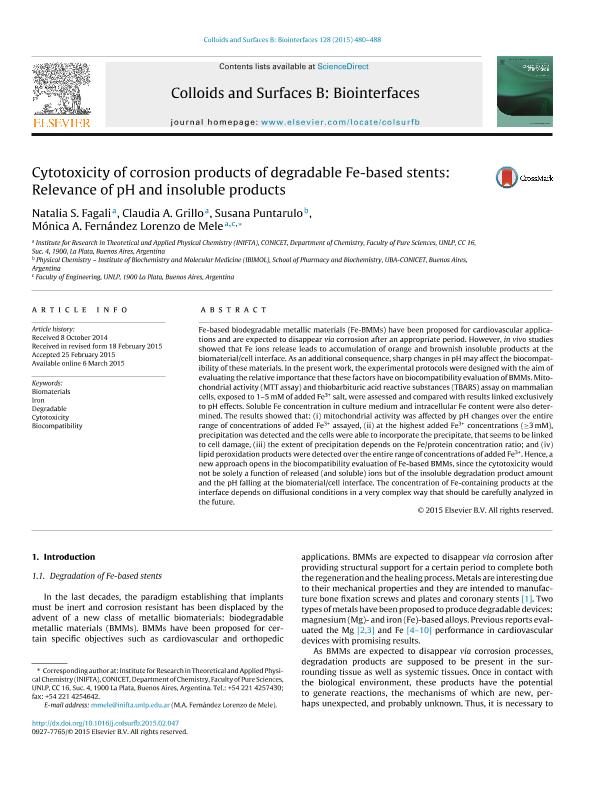Mostrar el registro sencillo del ítem
dc.contributor.author
Fagali, Natalia Soledad

dc.contributor.author
Grillo, Claudia Alejandra

dc.contributor.author
Puntarulo, Susana Ángela

dc.contributor.author
Fernandez Lorenzo, Monica Alicia

dc.date.available
2018-03-13T20:56:29Z
dc.date.issued
2015-04
dc.identifier.citation
Fagali, Natalia Soledad; Grillo, Claudia Alejandra; Puntarulo, Susana Ángela; Fernandez Lorenzo, Monica Alicia; Cytotoxicity of corrosion products of degradable Fe-based stents: Relevance of pH and insoluble products; Elsevier Science; Colloids and Surfaces B: Biointerfaces; 128; 4-2015; 480-488
dc.identifier.issn
0927-7765
dc.identifier.uri
http://hdl.handle.net/11336/38720
dc.description.abstract
Fe-based biodegradable metallic materials (Fe-BMMs) have been proposed for cardiovascular applications and are expected to disappear via corrosion after an appropriate period. However, in vivo studies showed that Fe ions release leads to accumulation of orange and brownish insoluble products at the biomaterial/cell interface. As an additional consequence, sharp changes in pH may affect the biocompatibility of these materials. In the present work, the experimental protocols were designed with the aim of evaluating the relative importance that these factors have on biocompatibility evaluation of BMMs. Mitochondrial activity (MTT assay) and thiobarbituric acid reactive substances (TBARS) assay on mammalian cells, exposed to 1-5mM of added Fe3+ salt, were assessed and compared with results linked exclusively to pH effects. Soluble Fe concentration in culture medium and intracellular Fe content were also determined. The results showed that: (i) mitochondrial activity was affected by pH changes over the entire range of concentrations of added Fe3+ assayed, (ii) at the highest added Fe3+ concentrations (≥3mM), precipitation was detected and the cells were able to incorporate the precipitate, that seems to be linked to cell damage, (iii) the extent of precipitation depends on the Fe/protein concentration ratio; and (iv) lipid peroxidation products were detected over the entire range of concentrations of added Fe3+. Hence, a new approach opens in the biocompatibility evaluation of Fe-based BMMs, since the cytotoxicity would not be solely a function of released (and soluble) ions but of the insoluble degradation product amount and the pH falling at the biomaterial/cell interface. The concentration of Fe-containing products at the interface depends on diffusional conditions in a very complex way that should be carefully analyzed in the future.
dc.format
application/pdf
dc.language.iso
eng
dc.publisher
Elsevier Science

dc.rights
info:eu-repo/semantics/openAccess
dc.rights.uri
https://creativecommons.org/licenses/by-nc-nd/2.5/ar/
dc.subject
Biocompatibility
dc.subject
Biomaterials
dc.subject
Cytotoxicity
dc.subject
Degradable
dc.subject
Iron
dc.subject.classification
Otras Biotecnologías de la Salud

dc.subject.classification
Biotecnología de la Salud

dc.subject.classification
CIENCIAS MÉDICAS Y DE LA SALUD

dc.title
Cytotoxicity of corrosion products of degradable Fe-based stents: Relevance of pH and insoluble products
dc.type
info:eu-repo/semantics/article
dc.type
info:ar-repo/semantics/artículo
dc.type
info:eu-repo/semantics/publishedVersion
dc.date.updated
2018-03-13T18:16:03Z
dc.journal.volume
128
dc.journal.pagination
480-488
dc.journal.pais
Países Bajos

dc.journal.ciudad
Amsterdam
dc.description.fil
Fil: Fagali, Natalia Soledad. Consejo Nacional de Investigaciones Científicas y Técnicas. Centro Científico Tecnológico Conicet - La Plata. Instituto de Investigaciones Fisicoquímicas Teóricas y Aplicadas. Universidad Nacional de La Plata. Facultad de Ciencias Exactas. Instituto de Investigaciones Fisicoquímicas Teóricas y Aplicadas; Argentina
dc.description.fil
Fil: Grillo, Claudia Alejandra. Consejo Nacional de Investigaciones Científicas y Técnicas. Centro Científico Tecnológico Conicet - La Plata. Instituto de Investigaciones Fisicoquímicas Teóricas y Aplicadas. Universidad Nacional de La Plata. Facultad de Ciencias Exactas. Instituto de Investigaciones Fisicoquímicas Teóricas y Aplicadas; Argentina
dc.description.fil
Fil: Puntarulo, Susana Ángela. Consejo Nacional de Investigaciones Científicas y Técnicas. Oficina de Coordinación Administrativa Houssay. Instituto de Bioquímica y Medicina Molecular. Universidad de Buenos Aires. Facultad de Farmacia y Bioquímica. Instituto de Bioquímica y Medicina Molecular; Argentina
dc.description.fil
Fil: Fernandez Lorenzo, Monica Alicia. Consejo Nacional de Investigaciones Científicas y Técnicas. Centro Científico Tecnológico Conicet - La Plata. Instituto de Investigaciones Fisicoquímicas Teóricas y Aplicadas. Universidad Nacional de La Plata. Facultad de Ciencias Exactas. Instituto de Investigaciones Fisicoquímicas Teóricas y Aplicadas; Argentina
dc.journal.title
Colloids and Surfaces B: Biointerfaces

dc.relation.alternativeid
info:eu-repo/semantics/altIdentifier/doi/http://dx.doi.org/10.1016/j.colsurfb.2015.02.047
dc.relation.alternativeid
info:eu-repo/semantics/altIdentifier/url/https://www.sciencedirect.com/science/article/pii/S0927776515001319
Archivos asociados
